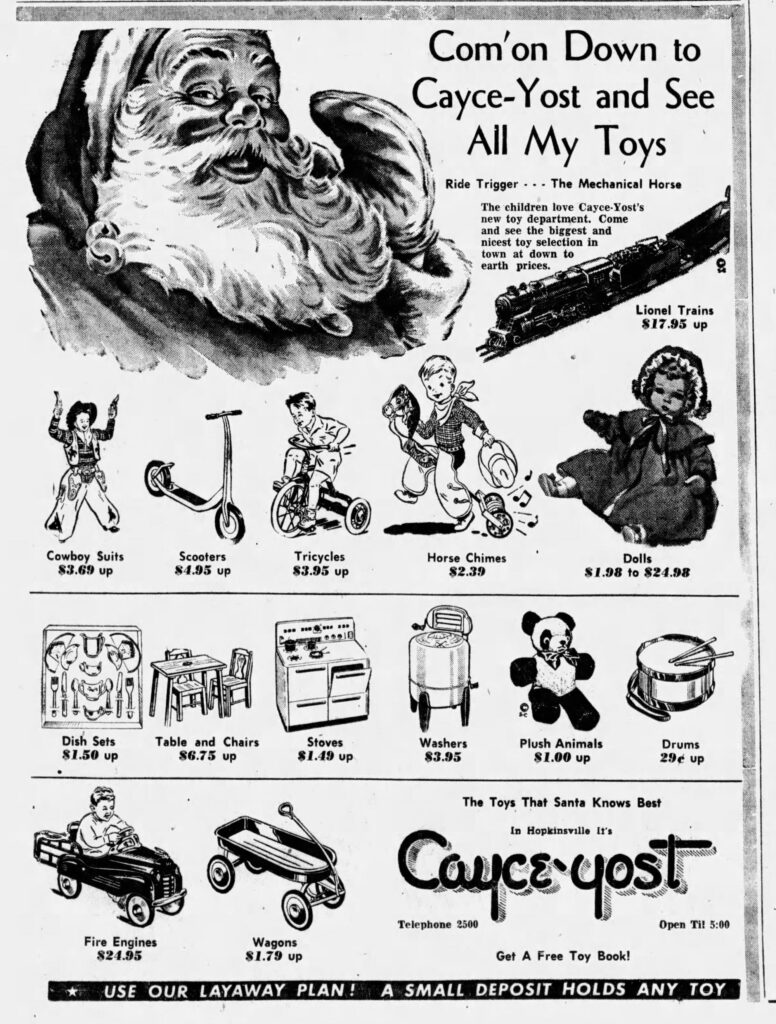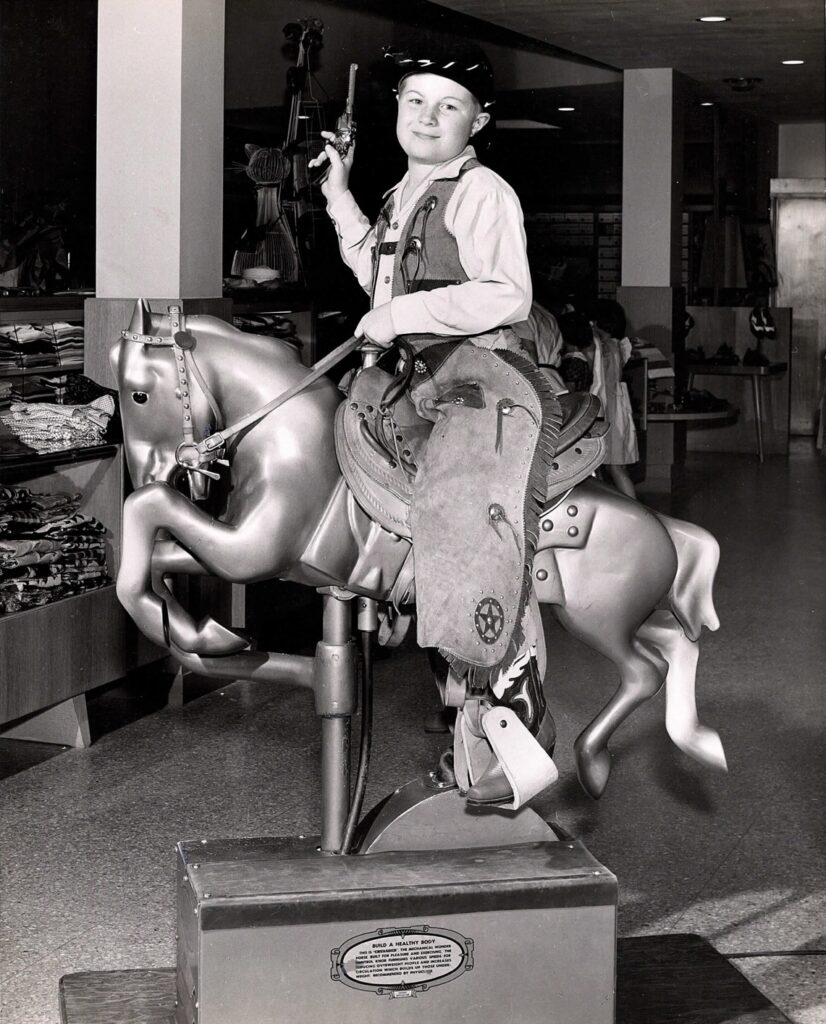Made of aluminum and set on a wooden base, this machine measures almost 5 feet tall. The base measures 28.5 inches wide and 53.5 inches long and has one remaining handle to aid in moving this heavy piece.
Mounted on top is a metal box containing a motor system from which an archaic electrical cord and a metal rod extend. Upon this rod, one of the most famous horses ever to reside in Hopkinsville stands firmly affixed. A coin box extends from a metal arm where kids deposited a dime for a ride. A pony saddle – worn from years and years of young riders – sits on his back. He weighs more than 400 pounds.
This month’s artifact is Crusader, the Mechanical Wonder Horse — easily one of the prized pieces in the collection of the Pennyroyal Area Museum.

I truly believe that Crusader is the most storied, the most loved, and – at least when it was purchased – the most controversial artifact that the museum owns. So many people have such strong memories of riding this mechanical horse when it lived in the toy department at Cayce-Yost department and hardware store on Main Street. I want to say that I am one of those people, but sadly, I am not. I have distinct memories of the store, but somehow, I have none of the horse itself. This lack in my own personal connection to our community’s collective memory makes me even more pleased that this iconic character now lives at the museum.
The early days of Cayce-Yost

Cayce-Yost long stood as the center of commerce in downtown Hopkinsville. Incorporated in 1907, the store established the business partnership of brothers George and Harry Yost and Delbert D. Cayce. The Yosts moved here from Illinois, and their father opened F.A. Yost Company, which specialized in the making and selling of trunks, harnesses and saddles. Cayce, a former tenant farmer, worked at Planters Hardware Company after moving to Hopkinsville from the county. He joined in business with the Yost brothers after their father passed away. After 10 successful years in 1917, the name of the business was changed to Cayce-Yost Company.
In 1951, Cayce-Yost moved from its original location on the northeast corner of Main and 10th streets to the southeast corner of the same block, just a short hop over 10th Street. In the new building, the store offered hardware, paint, sporting goods, appliances, furniture, repair and a year-round toy department. It’s the toy department on the second floor seems to linger most vividly in so many people’s minds.
Debut of a ‘health builder’ for Hopkinsville

Based on what I could find, it appears that it was also in 1951 that Crusader made his debut in Hopkinsville. On Nov. 8 of that year, an ad for the store featuring Santa Claus invited kids to “Ride Trigger…The Mechanical Horse.” His name, an obvious shout-out to Roy Rogers’s famed equine sidekick, doesn’t match the sticker on our horse, but I think they are one in the same.
Produced by the Memphis Metal Manufacturing Company, the mechanical horse started its career as much more than a children’s toy found in department stores. As indicated by the words “Health Builder” on its coin box and the large sticker on its metal base, this apparatus was initially created as a piece of weight loss equipment. The sticker reads:
Build a Healthy Body
This is ‘Crusader,’ the Mechanical Wonder Horse, built for pleasure and exercising. The control knob furnishes various speeds for reducing overweight people and increases circulation which builds up those underweight. Recommended by physicians.
Who would’ve guessed?! Crusader not only entertained kids, but it kept the children of our community healthy! That’s a big deal.
Almost three years ago, a woman contacted the museum about the horse. She was actively restoring one of Crusader’s cousins and needed a few measurements and details from our horse to help with her process. It turns out that in spite of decades of usage and hours and hours of bouncing children, our Crusader is in remarkably good condition. We happily provided her with what she requested, and in return, she sent us a load of information about the history of these magical steeds. She received this information in a roundabout way from a man named William B. Mason Jr., the son of one of the founders of the Memphis Metal Manufacturing Company. All of the information that I have on Crusaders comes from him.

A special request
Incorporated in 1945, the Memphis Metal Manufacturing Company initially produced steel and aluminum fan venturi in varying sizes. This production would make up the bulk of their business until the company ended all manufacturing operations in 2018. In 1948, however, a Memphis grocer came to the metal company with a request. He wanted them to fabricate a machine to help him lose weight. He had seen and used such a thing when he traveled to Battle Creek, Michigan, and he hoped to have one designed and built for use at home.
C.T. Small, an inventor employed by Memphis Metal, was put on the task. Using descriptions from the overweight grocer, Small designed what was basically a 30-gallon barrel mounted on a rod and connected to a motor that made it move up and down at variable speeds. To give it some pizazz, the team cut out a horse head and tail out of flat sheet metal and affixed a saddle to give the big man a place to sit. An article in the Memphis Press-Scimitar on June 9, 1949, shared that the man lost 20 pounds after only two weeks of use!

In 1949, William Mason, one of the owners of the metal company, came up with a plan to redesign the machine to make it more fun, attractive, and to look less like a barrel and more like a horse. He partnered with the Southern Amusement Company who agreed to promote and sell horses to department stores on commission. In 1950, a Crusader prototype hit the road in the mid-South and was displayed at an international trade show in Chicago.
The first horses were painted with Dupont gold metallic automotive lacquer, with a black-and-white pinto design becoming the preferred breed in 1951. Approximately 900 horses were manufactured between 1950 and 1953 when a scarcity of pig aluminum caused by the Korean War brought production to a halt. That same year, other manufacturers introduced fiberglass horses to the market at about a third the cost of the metal Crusader. After only three years in production, no more Crusaders were ever built again.
Our Crusader bears the number 205 and appears to have the early gold paint scheme — meaning it was likely one of the earliest ones manufactured. I think it was purchased by Cayce-Yost around 1951 and likely cost about $850. To give some perspective, that would be close to $10,500 in today’s cash. That is a lot of capital to make up for a dime at a time. I have a feeling, though, that the horse paid for itself quickly.
A Hopkinsville relic
The last Amusement Machine License expired on June 30, 1989; however, an article by Jennifer Brown in the Kentucky New Era proves that Crusader was still bringing joy to kids until at least 1991. K.O. Cayce, Sr., owner of Cayce-Yost and the man we can all thank for purchasing Crusader, told Brown then that three generations of folks had taken their turn in Crusader’s saddle. The article noted that Crusader vibrated the entire second floor of the building and that even those on the first floor could hear when he was being taken for a ride.

Crusader maintained his prestigious spot in the toy department in Cayce-Yost until the store closed in 1994. Citing too much competition from big box stores like Walmart, Cayce-Yost ended its 87-year career. On May 21 of that year, a big auction took place to sell off items from the store. To no one’s surprise, Crusader was the star of the show.
With a sense of purpose and an unmatched determination, William T. Turner hollered out the winning bid on behalf of the Pennyroyal Area Museum. According to the newspaper report, most folks thought the mechanical horse would go for around $2,500. Bidding against a retailer from Princeton whose uncle owned the Memphis Metal company, the museum paid $6,400 (or more than $13,000 today) — much to the surprise and question of many in the community.
That was a lot of money for the museum in 1994. That is a lot of money for the museum today! But I commend William for his foresight in keeping Crusader where he belongs: here, in Hopkinsville, where he has been since 1951.
Crusader, the Mechanical Wonder Horse, remains in the main gallery of the Pennyroyal Area Museum, a place where more and more generations can come to visit him. I understand that he still works — but we haven’t plugged him up and taken him for a ride in a while. Maybe I’ll make him part of my exercise routine in the New Year.
Alissa Keller is the executive director of the Museums of Historic Hopkinsville-Christian County. She’s a graduate of Centre College with degrees in history and English and of Clemson University/College of Charleston with a master’s degree in historic preservation. She serves on the Kentucky Historical Society and the Kentucky Museum and Heritage Alliance boards.




